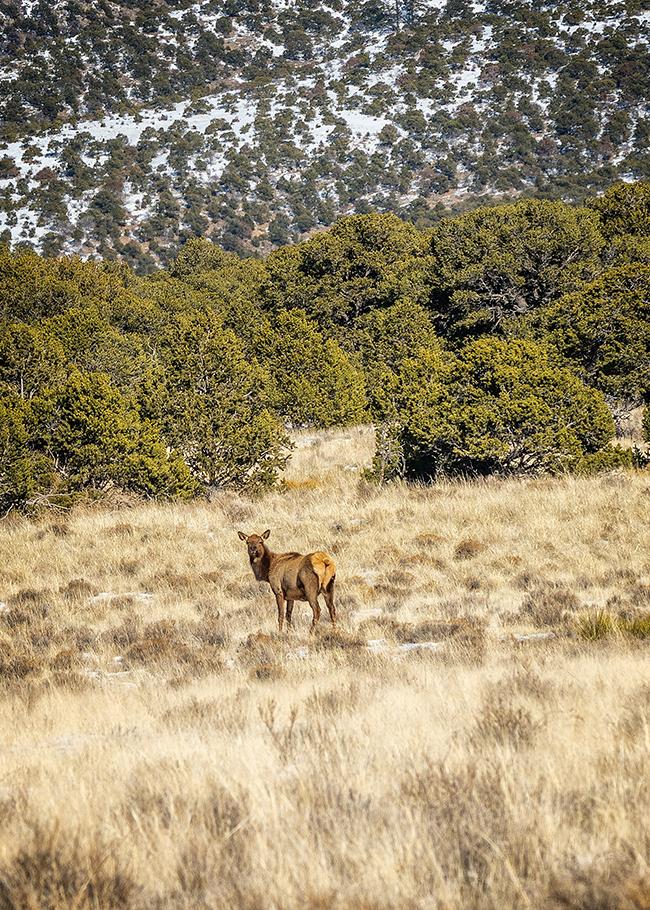There are 78 species of animals (mammals, reptiles, amphibians, fish) and over 250 species of birds, that either call Great Sand Dunes home, or pass through the park at some point in time. There are insects, too, including seven species found only at Great Sand Dunes and nowhere else, including the Great Sand Dunes Tiger Beetle.

You might see one or more elk during your visit to Great Sand Dunes National Park and Preserve / Rebecca Latson
During a visit to the park, the animals you may commonly see are elk, mule deer, and pronghorn. But, that’s not all you might see. The wildlife you observe depends upon which ecosystem within the park you are exploring. For instance, of the mammals you may see, water shrews and beavers reside within the park’s riparian ecosystem of streams and other wet areas. Black bears roam those same locations, too, feeding upon the abundant vegetation and small animals.
Abert’s squirrels (nicknamed “scrabbits” due to their long ears) and mountain lions may be found within the park’s montane forests, along the drier foothills of the Sangre de Cristo Mountains, 8,000 ft (2,438m) to 9,500 ft (2,896m). FYI, sightings of mountain lions are rare, but it’s possible to find tracks in the mud or snow.
If you are on the dunes, you might spy one of the only mammals in the park that can live their entire lives in the dunefield: the Ord’s kangaroo rat. Of course, you’ll have to be exploring the dunes at night, since Ord’s kangaroo rats are nocturnal.
There are even 2,000 bison currently ranched within park boundaries on land owned by The Nature Conservancy. Presently, this private inholding not open to the public but you might still see these behemoths through your binoculars or telephoto lens.
It’s not just sand dunes in this national park, you know. Sure, the dunefield is the star of the show, but there are much wetter areas within which dwell amphibians, including one salamander species. Some of these amphibians can live at very high elevations, like the tiger salamander and the chorus frog. Fun fact: these two survive the long winters at high elevations in this park by freezing themselves then thawing back out in the spring! All amphibians are quite well camouflaged – some, like the spadefoot, blend in with its environment so well, you might not even see it unless it moves.

The spadefoot blends in very well with its environment, Great Sand Dunes National Park and Preserve/NPS file
Great Sand Dunes is a high-elevation park, so while reptiles do live within park boundaries, there aren’t very many – just seven species. There are snakes in the park, but you won’t see them in the dunes, and no venomous snakes have ever been found. What reptiles live there, though, are pretty interesting. You might spot a tiny short-horned lizard measuring around 2.5 inches (6.35 cm) in the sandy grasslands or fine gravels of the subalpine forest. A “dwarfed population,” the short-horned lizards in the park are about half the size of short-horned lizards found in other parts of Colorado and North America.
If you are really lucky, you might encounter a skink, although that would be a rare sighting indeed. Skinks look like smooth-skinned lizards. If you grab their tail, it will detach as a defense mechanism allowing the skink to escape. But, if you see a skink, don’t grab its tail, ok?
Of the 250 species of birds found in the park, the most iconic species is the sandhill crane, over 20,000 of which will land in the San Luis Valley and park wetlands during February and September on their migration to and from the northern U.S. and Canada. If plan to visit Great Sand Dunes in February or September, check out this page for more information on viewing sandhill cranes during their migration.

Sandhill cranes in flight, Great Sand Dunes National Park and Preserve / NPS - Patrick Myers
Depending upon the area you explore within the park, you might see Western tanagers, white-tailed ptarmigans, golden eagles, mountain bluebirds, and northern pygmy owls, to name a few. Venture a little way outside of the park into nearby wetlands and you’ll likely view herons and avocets. Click here for a downloadable PDF checklist of birds found in Great Sand Dunes National Park and Preserve.
The creeks of the Sangre de Cristo Mountains are important habitats for the fish in Great Sand Dunes. Medano Creek and Sand Creek serve as biological refugia for the Rio Grande cutthroat trout, which once occupied the Rio Grande Basin and associated drainages in southern Colorado and New Mexico, but now only occupies onlyabout 15 percent of that range. There are other fish in the park, too, such as grand sucker rainbow trout and brook trout.
If you feel like dropping a line to see what you might catch, check this page about fishing at Great Sand Dunes. FYI, the Rio Grande cutthroat trout is catch and release only, as it is on the candidate list for threatened/endangered species status at the federal level.
When you see wildlife, keep a safe distance away from it. Anything large, like elk or black bears, should dictate you remain 100 yards (300 ft / 91 m) away. Capture those close-up shots with your telephoto lens or your smartphone’s telephoto setting. If you can’t get a close-up shot, then incorporate that wildlife into your landscape photos to show people the environment in which that wildlife roams and feeds.
Here’s a Complete List of Mammals, Reptiles, Amphibians, and Fish of Great Sand Dunes National Park and Preserve you can download and print.





